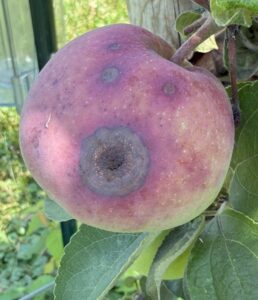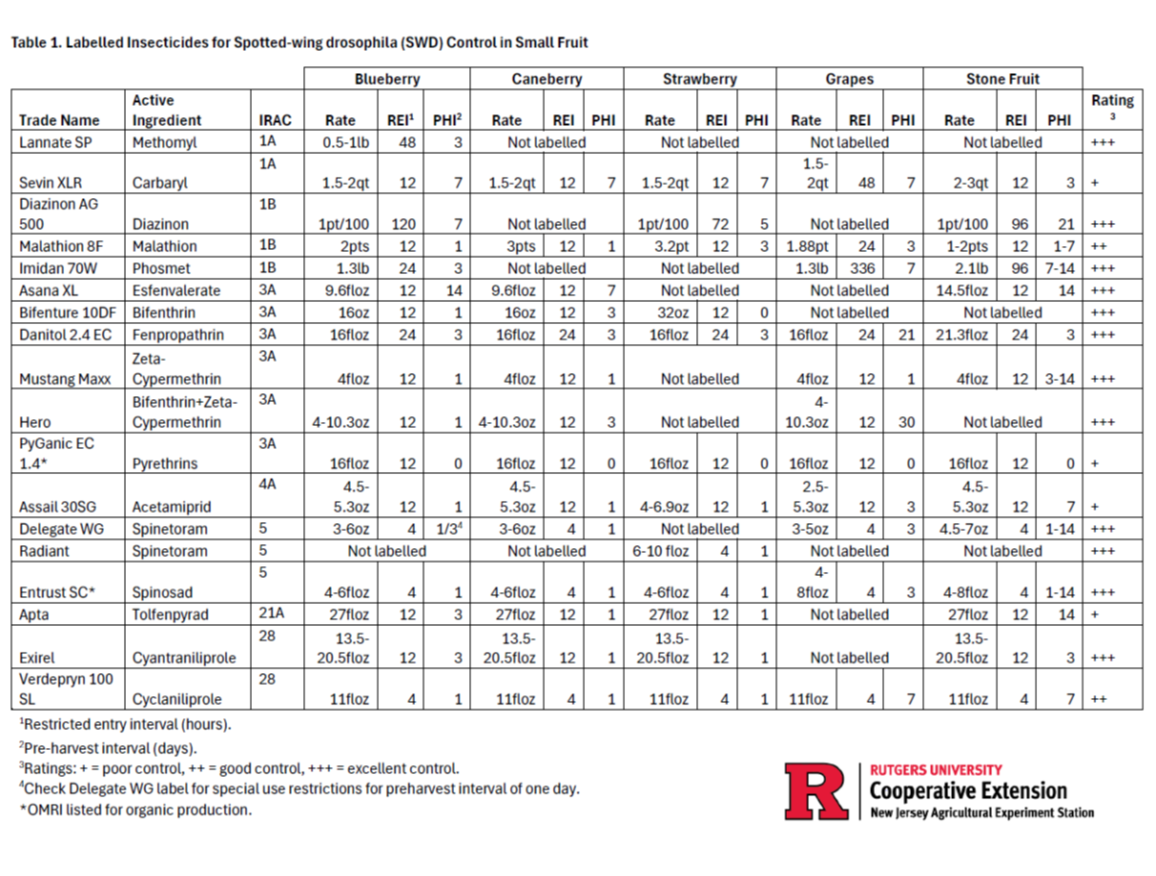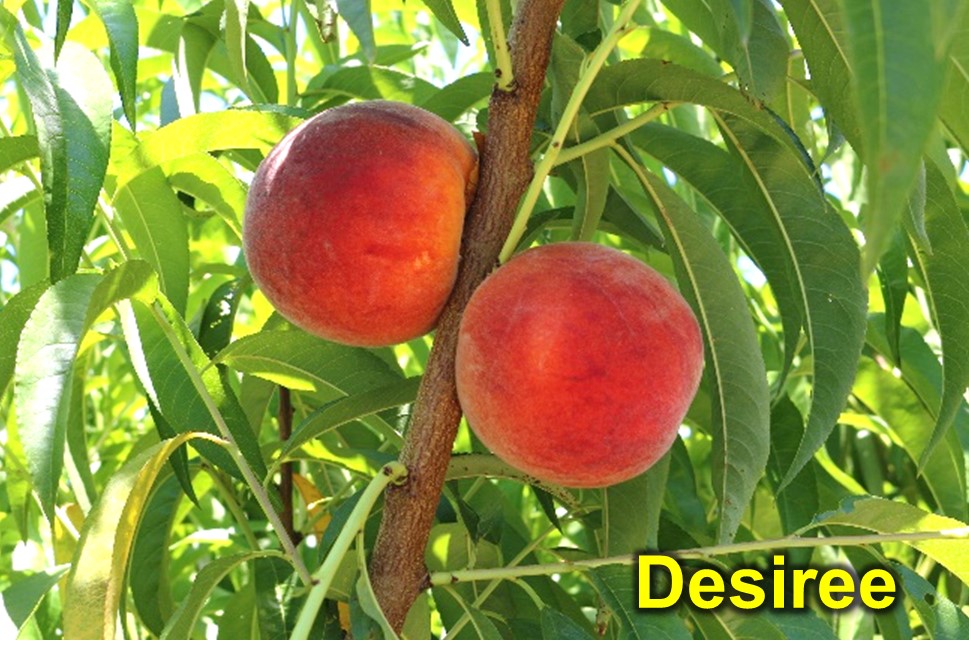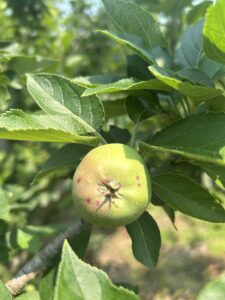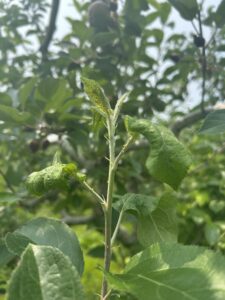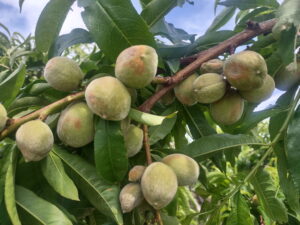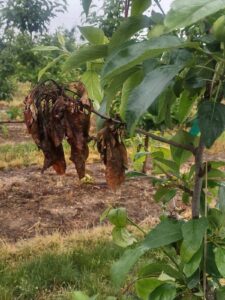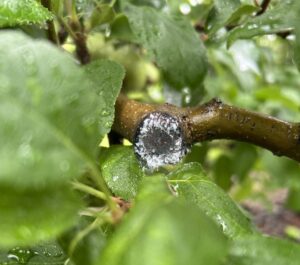Peach:
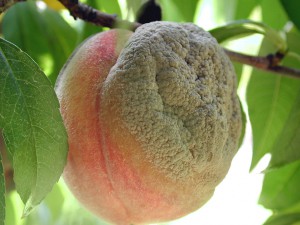
Figure 1. Brown rot on mature fruit. Entire surface of lesion is covered with spores.
Brown Rot: Warm and wet weather this summer have been ideal conditions for brown rot to develop on fruit (Figure 1). Most growers should be relying on a captan based program for mid-season covers, followed by better materials during the last 3 weeks pre-harvest. For reference see Dr. Norm Lalancette’s post Improving Your Late Season Peach Brown Rot Control Program — Plant & Pest Advisory.
Tarnished Plant Bugs; and Other Cat-facing Insects: Cat-facing insect activity is increasing with the arrival of hot weather and is present at moderate to high levels in some orchards.
Oriental Fruit Moth: A biofix point for OFM was set on 4/2 for southern counties and 4/17 in northern counties. See below for timings for third generation.
| OFM 3nd Generation Timing | ||||
| Insecticide Type | ||||
| County/Region | Degree Days by 7/7 base 45 | Conventional
2100-2200 2450-2500 |
Intrepid/Rimon
2000-2100 2350-2450 |
Diamides/Virus
2025-2150 2375-2450 |
| Gloucester – Southern | 1971 | 1st –7/11-7/14
2nd – 7/22-7/24 |
1st –7/8-7/11
2nd – 7/19-7/22 |
1st –7/9-7/12
2nd – 7/20-7/22 |
| Middlesex – Northern | 1790 | 1st – 7/17-7/20
2nd – too far off |
1st – 7/14-7/17
2nd – too far off |
1st – 7/15-7/18
2nd – too far off |
Scale Insects: Second generation White Peach Scale crawlers should emerge sometime this week or next. Second generation San Jose Scale crawlers emerge about 7/17 +/- 8 days. Esteem is a good scale material that has a 14-day PHI for stone fruit. Centaur is also effective, has a 14-day PHI and can be used only once during the growing season. Venerate has shown efficacy as a pre-harvest treatment against scale and has a 0-day PHI. If using Venerate to control scale insects, make 2 applications 7 days apart starting a week after crawler emergence.
Japanese Beetles: Japanese beetle activity has been noticeable in many orchards. Products containing imidacloprid are standard insecticides for Japanese beetle control and have a short PHI. See the NJ Commercial Tree Fruit Production Guide for more information.
Apples and Pears:
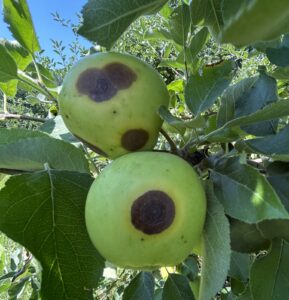
Figure 2. Bitter rot infection on apple.
Diseases: Now that primary scab has ended, the focus turns toward summer diseases such as fruit rots (esp. Bitter rot; Figure 2), and sooty blotch and fly speck. Bitter rot control has been difficult at best in recent years even where management programs have been rigorous. Research has suggested products such as Merivon, Luna Sensation, Inspire Super, Omega, and Aprovia may be effective, and longtime reliable broad-spectrum fungicides such as captan and ziram should provide control. Experience has suggested that the addition of phosphorous acid products such as Prophyt or Rampart to captan sprays may improve control. Observations are that these products improve control of other summer diseases such as sooty blotch and flyspeck, and may help suppress scab infections where present. Bitter rot symptoms have been observed in both southern and northern counties.
Brown Marmorated Stink Bugs: Brown Marmorated Stink bugs are present at low to moderate levels in orchards statewide. Eggs are hatching and nymphs are present. See the NJ Tree Fruit Production guide for effective materials.
Codling Moth (CM): Second generation timings are updated below. Trap counts and emergence are low. Therefore, if you have applied your 2nd generation insecticides and your trap counts are low (less than 5 moths per trap), additional treatments are not needed.
| Codling Moth Degree Day Timing – Second Generation | ||||||||
| Application and Insecticide Type | ||||||||
| County Area | Biofix | Rimon:
75-100DD + 14-17 days later
|
Intrepid
1150 + 1450 DD Diamides – Altacor, Voliam mixes: (150-200 DD) |
Madex
1250 DD + every 7-9 days during brood hatch (later if first spray is an IGR) |
Standard Insecticides – Delegate, Avaunt, OP’s, carbamates, pyrethroids
1250 DD + 1550 DD
|
|||
| DD | 1150 | 1450 | 1250 | 1250 | 1550 | |||
| Southern | April 28 | N/A | N/A | past | 7/10 | past | past | 7/13 |
| Northern | April 30 | N/A | N/A | past | 7/13 | 7/7 | 7/7 | 7/17 |
Scale Insects: Second generation San Jose Scale should emerge about mid-July. Options include Esteem (2 applications/year; 45-day PHI); Centaur (1 application/year; 14-day PHI); Diazinon 50W (2 applications/year; 21-day PHI); Venerate (0-day PHI; Make two applications 7 days apart starting a week after crawler emergence).
Phenology Table: Based on annual observations made in Gloucester County.
| Pest Event or Growth Stage | Approximate Date | 2025 Observed Date |
| Bud Swell (Redhaven/PF-17) | March 23 +/- 15 Days | March 30 |
| 1/4″ Green Tip Red Delicious | March 31 +/- 13 Days | March 30 |
| Pink Peach (Redhaven/PF-17) | April 4 +/- 15 Days | April 1 |
| Tight Cluster Red Delicious | April 9 +/- 13 Days | April 5 |
| Full Bloom Peach (Redhaven/PF-17) | April 9 +/- 14 Days | April 10 |
| Pink Apple (Red Delicious) | April 14 +/- 12 Days | April 16 |
| Full Bloom Apple (Red Delicious) | April 22 +/- 11 Days | April 25 |
| Petal Fall (Redhaven) | April 22 +/- 10 Days | April 19 |
| Petal Fall (Red Delicious) | April 27 +/- 13 Days | May 2 |
| Shuck Split (Redhaven) | April 30 +/- 11 Days | April 26 |
| Pit Hardening | June 15 +/- 9 Days | June 15 |
Tree Fruit Trap Captures – Southern Counties
| Week Ending | STLM | TABM-A | CM | BMSB | OFM-A | DWB | OFM-P | TABM-P | LPTB | PTB |
| 4/5/2025 | 0 | 0 | 0 | 0 | 0 | 0 | 0 | 0 | 0 | 0 |
| 4/12/2025 | 0 | 0 | 0 | 0 | 6 | 0 | 0 | 0 | 0 | 0 |
| 4/21/2025 | 0 | 0 | 0 | 0 | 36 | 0 | 1 | 0 | 0 | 0 |
| 4/27/2025 | 25 | 0 | 0 | 0 | 24 | 0 | 5 | 0 | 1 | 0 |
| 5/2/2025 | 517 | 0 | 4 | 0 | 12 | 0 | 6 | 0 | 13 | 0 |
| 5/9/2025 | 159 | 4 | 10 | 0 | 3 | 16 | 5 | 4 | 46 | 0 |
| 5/16/2025 | 91 | 11 | 6 | 0 | 1 | 36 | 2 | 14 | 69 | 0 |
| 5/23/2025 | 299 | 21 | 3 | 0 | 1 | 23 | 1 | 26 | 23 | 0 |
| 5/30/2025 | 399 | 14 | 2 | 0 | 0 | 41 | 1 | 11 | 10 | 3 |
| 6/6/2025 | 733 | 13 | 1 | 0 | 0 | 36 | 2 | 12 | 29 | 1 |
| 6/13/2025 | 684 | 19 | 2 | 1 | 0 | 81 | 2 | 17 | 22 | 8 |
| 6/20/2025 | 724 | 24 | 2 | 0.5 | 1 | 60 | 1 | 23 | 19 | 12 |
| 6/27/2025 | 932 | 5 | 1 | 0.8 | 1 | 40 | 0 | 5 | 24 | 14 |
| 7/4/2025 | 643 | 0 | 0 | 0.75 | 1 | 17 | 0 | 0 | 6 | 16 |
Tree Fruit Trap Captures – Northern Counties
| Week Ending | STLM | TABM-A | CM | BMSB | OFM-A | DWB | OFM-P | TABM-P | LPTB | PTB | AMBROSIA BEETLE |
| 4/5/2025 | 387 | 0 | 0 | 0 | 0 | 0 | 0 | 0 | 0 | 0 | 0 |
| 4/21/2025 | 435 | 0 | 0 | 0 | 0 | 0 | 1.3 | 0 | 0 | 0 | 0 |
| 4/27/2025 | 26 | 0 | 0 | 0 | 0 | 0 | 25 | 0 | 0 | 0 | 72 |
| 5/2/2025 | 86 | 0 | 0.33 | 0 | 72.5 | 0 | 47.2 | 0 | 0 | 0 | 136 |
| 5/9/2025 | 56 | 0 | 5.3 | 0 | 58.8 | 0 | 22.9 | 0 | 0 | 0 | 145 |
| 5/16/2025 | 13.75 | 2.6 | 7.3 | 0 | 4 | 0 | 5 | 0 | 0 | 0 | 50.5 |
| 5/23/2025 | 4.8 | 10.3 | 10.5 | 0 | 0.6 | 31.25 | 4.2 | 0 | 14.6 | 1 | 22.2 |
| 5/30/2025 | 2.2 | 4.8 | 1.8 | 0 | 0 | 12.4 | 9.6 | 0 | 9.6 | 1.9 | 22.1 |
| 6/6/2025 | 3 | 4.83 | 2.8 | 0.25 | 0 | 20 | 4.1 | 0 | 21.2 | 1.8 | 40.3 |
| 6/13/2025 | 65 | 20 | 11.4 | 0.6 | 0 | 12.3 | 4 | 0 | 10.5 | 1.5 | 59.2 |
| 6/20/2025 | 26 | 26 | 8 | 0.75 | 1 | 13 | 4.5 | 0 | 11 | 0.75 | 52 |
| 6/27/2025 | 145 | 19 | 6 | 1.3 | 6 | 35 | 5.4 | 0 | 16 | 1.6 | 38 |
| 7/4/2025 | 212 | 6 | 3 | 6 | 12.5 | 40 | 2 | 0 | 8.4 | 1.1 | 27 |
Grape: The next timing for Grape Berry Moth will be on or about 7/24 for Intrepid or Diamides, or a few days later for other insecticides based on the biofix of May 24 in southern counties. Treatments for the third generation are at an accumulation of 1620 degree days (base 47.14).
Blueberry: Spotted-wing drosophila, Oriental beetle, and Sharp-nosed leafhopper have increased from the previous week. Blueberry maggot trap counts remain low. For weekly reports on blueberry pests and recommendations read the Rutgers Blueberry Bulletin.
| Week Ending | SWD AC Traps | SWD BC Traps | OB AC Traps | OB BC Traps | ||||
| AVG | HIGH | AVG | HIGH | AVG | HIGH | AVG | HIGH | |
| 6/6/25 | 8.5 | 29 | 3 | 9 | 7.8 | 29 | 0 | 0 |
| 6/13/25 | 21.51 | 45 | 32.6 | 86 | 240 | 1350 | 34 | 170 |
| 6/20/25 | 37.52 | 148 | 37.6 | 83 | 405 | 2025 | 555.4 | 4050 |
| 6/27/25 | 13.5 | 34 | 27.4 | 67 | 681 | 2025 | 134.9 | 450 |
| 7/4/25 | 21.2 | 73 | 41.1 | 64 | 541 | 2025 | 331.6 | 1575 |
| SWD = Spotted-Wing Drosophila, OB = Oriental Beetle; AC = Atlantic County, BC = Burlington County | ||||||||
| Week Ending | BBM AC Traps | BBM BC Traps | SNLH AC Traps | SNLH BC Traps | ||||
| AVG | HIGH | AVG | HIGH | AVG | HIGH | AVG | HIGH | |
| 6/6/25 | 0 | 0 | 0 | 0 | 1 | 6 | 0.85 | 3 |
| 6/13/25 | 0.29 | 7 | 0.16 | 4 | 1.26 | 8 | 3.27 | 17 |
| 6/20/25 | 0 | 0 | 0.04 | 1 | 1.28 | 8 | 4 | 16 |
| 6/27/25 | 0.05 | 4 | 0 | 0 | 0.25 | 1 | 0.28 | 2 |
| 7/4/25 | 0 | 0 | 0 | 0 | 0.81 | 13 | 1.17 | 4 |
| BBM = Blueberry Maggot, SNLH = Sharp-nosed Leafhopper; AC = Atlantic County, BC = Burlington County | ||||||||
